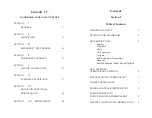
5
Tandem spreader bar
The PASHA 3 tandem spreader-bar allows varied attachment possibilities, allowing
for the difference in heights and weights of pilot and passenger. Changing the main
attachment (karabiner - min. strength 24 kN) position can allow for weight difference:
the front position (3) for heavier passengers, the middle position (4) if their weights
are the same and the back position (5) for lighter passengers. The passenger weight
is always compared to the weight of the pilot!
Adjustment of the passenger's karabiner hang point can allow for height differences. The
pilot's attachment is on hanging point (6) (see the picture below).
The rescue system bridle must be connected to main suspension point on the spreader-
bar (3, 4 or 5). It is possible to use a separator karabiner (min. strength 24 kN) for the
rescue system, clipped in to the same loop as the main karabiner. The rescue system
bridle must not be connected only to the pilot's or passenger's harness or to the
spreader-bar's hang points.
1) Passenger´s hang point.
2) Trimm.
3) Main suspension and rescue system attachment point, when passenger is heavier than the pilot.
4) Main suspension and rescue system attachment point, when passenger is the same weight as
the pilot.
5) Main suspension and rescue system attachment point, when passenger is lighter than the pilot.
6) Suspension point for the pilot.
An optimal outfit should be standard for every paraglider pilot. Always wear stout
footwear, a helmet, and gloves. Clothing should be warm and allow sufficient freedom
of movement. Check if you and your passenger are dressed properly.
An emergency rescue-system can be life-saving in case of mid air collision,
irrecoverable collapses or material failure, and is therefore imperative.
All biplace harnesses with the DHV GH approval are suitable for use on the PASHA3.
.
WARNING: The karabiners used in position 3, 4 or 5 must be karabiners designed for
tandem flight, which means the minimum strength must be 24 kN. (Recommendation
Austrialpin Powerfly, Austrialpin Delta). This holds also for the karabiner used for the
attachment of the rescue system in Position 3, 4 or 5. (Recommendation: Maillon
Rapide 6/7 mm)
Safety equipment
6
FLYING OPERATIONS
6
New glider check and before every flight check
Forward launch
A tandem glider is often used by more than one pilot, ensure that all of them know the
operating limits well and will observe these rules.
In addition to all the usual pre-flight checks, please pay particular attention to the items in
the following checklist:
1. Inspection of canopy for tears or damage, especially the seams which join the ribs to
the upper and lower surfaces, also the area of the attachment tapes and brake-line
connections.
2. Inspection of the lines for damage, including to the stitches on the connecting loops. It
is also important to check the suspension lines and brake-lines for tangles. The line
lengths must be checked after 50 hours flying time and whenever the flight behaviour of
the glider changes.
3. Inspection of the risers and maillons for faultless condition. Pay special attention to
maillons for traces of corrosion under the lines.
4. Inspection of the knotting of the steering handle to the brake-lines. The brake-lines
must run freely.
5. Inspection of the tandem spreader bar for damage.
6. Inspection of both harnesses. The harness must show no signs of wear or other
damage. You must also check the harness after a hard landing.
7. Check that the rescue-system is correctly installed and secured.
8. Inspection of the main karabiners. Inspection of attachment and security of the
karabiners.
Find a suitable take-off spot, from which you can abort the take-off at any point. After
checking the glider, following the checklist, lay it out with the cell-openings upwards so
that the canopy forms the shape of a horseshoe. In a strong wind don't spread the
canopy too far, so that there is less resistance when pulling up.
This is possible in almost all wind conditions except strong headwinds. It is essential to
stand in line with the canopy, especially when the glider has longer lines. Before take-off,
place yourself centrally at the gliders axis. Let the B C and D-risers fall into the crook of
your arm and pull the canopy dynamically up by all A-risers = (A+A1). The stronger the
headwind the less run-up you need to pull the canopy up. As soon as the glider is above
you, stop pulling on the A-risers.
Checklis
Take-off
WARNING! Remember; don't take off with a wet glider. In such conditions it will be
more difficult to launch and the glider's behaviour in extreme situations can be
different from that of a dry glider.
FLYING OPERATIONS






















